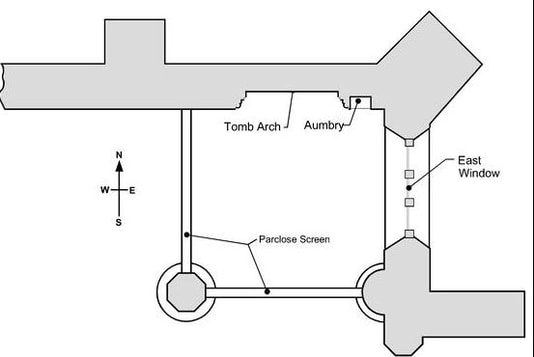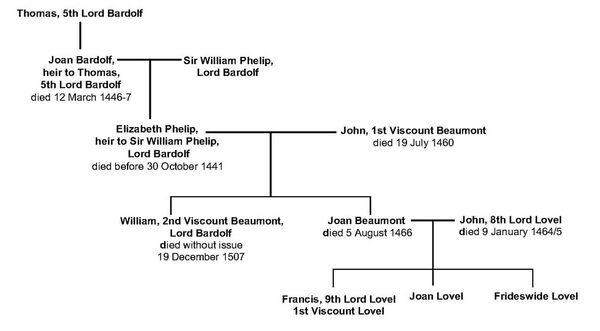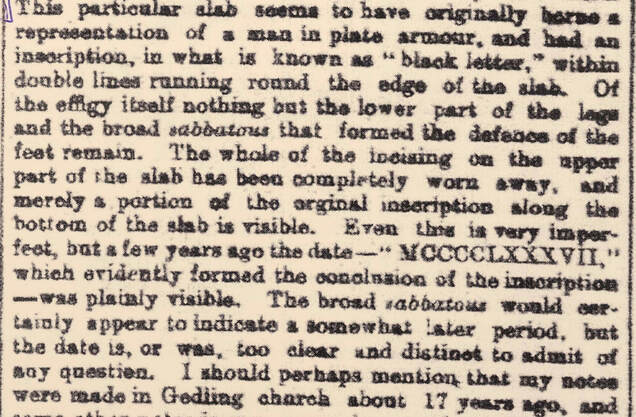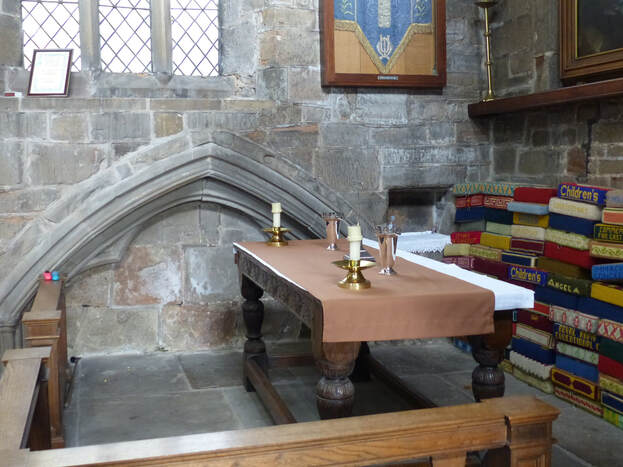
The Chantry Chapel in the North Aisle at Gedling
At the east end of the north aisle there are the remains of a chantry chapel which include a tomb arch, an aumbry and a window. It was surrounded by a parclose screen until the church was restored in 1872 and a new chapel was built on the site of the chantry chapel in 1978. The picture below shows the tomb arch and aumbry with an altar in a similar position to that of the original one in the chantry chapel. A painting has been placed on the sill of the east window.
At the east end of the north aisle there are the remains of a chantry chapel which include a tomb arch, an aumbry and a window. It was surrounded by a parclose screen until the church was restored in 1872 and a new chapel was built on the site of the chantry chapel in 1978. The picture below shows the tomb arch and aumbry with an altar in a similar position to that of the original one in the chantry chapel. A painting has been placed on the sill of the east window.

Earlier glazing in this window provided a connection with Francis Lovel, because when Robert Thoroton visited the church in 1677 he reported that he had seen the arms of the Bardolf family quartered with those of the Beaumonts in the stained glass of the east window of the north aisle. [1]
The union of the two families came about when Francis’s grandmother, Elizabeth Phelip married John, the first Viscount Beaumont and provides further evidence of Francis Lovel’s connection with Gedling church.
The tomb arch and the alabaster slab
The Gedling tomb arch contains neither effigy or slab to identify the person being commemorated, but there is an alabaster slab which is now located at the east end of the chancel that was the subject of some investigation in the nineteenth century.

Alfred Edward Lawson Lowe, who was a Fellow of the Society of Antiquaries and a noted writer on church memorials, wrote a letter to The Nottinghamshire Guardian, in which he said that he had visited the church in 1866 and had read the date for the year of the battle on an alabaster slab which showed the lower part of a man wearing a suit of armour. He suggested that the slab may have commemorated Francis, Viscount Lovel and that a colleague of his made a similar observation a few years later. [2]

The surface of this slab is very badly worn and has suffered further wear since Lowe saw it. It has been reduced in length to 5 ft. 3ins. enabling it to be fitted into a nineteenth-century re-paving of the chancel.
The most recognisable feature that remains is the left foot. The curved lines show that the man is wearing a sabbaton a form of footwear that was part of a suit of armour.
Could the Gedling chantry chapel have commemorated someone else?
Someone from outside the parish?
Everyone had the right to be buried in the church or churchyard of the parish in which they died, so it is very unlikely that the person buried under the tomb died outside the parish of Gedling.
On rare occasions, bodies were transported to another parish to enable them to be buried with their ancestors in their family's mortuary chapel but that does not apply here because there is only one tomb.
Someone from within the parish?
Records of the 1525 Subsidy show that none of the inhabitants of the parish were wealthy enough to have paid for an alabaster slab which cost £10-20 from the quarry, let alone build and furnish a chantry chapel.[3]
The Lord of the Manor?
The Lords of the Manor were the Bardolf family who did not live in the parish after about 1350. The Stanhope family were Lords after 1537 but they too lived elsewhere. From 1304 when the first Lord Bardolf died, to 1547 when chantries were abolished, the Bardolfs and their descendants provided eight lords of which six were recorded as having been buried elsewhere. Only the burial sites of the first Lord and the third one who died in 1363 remain unidentified. They too can be eliminated because details of the masonry of the chapel at Gedling show that it was built later than the date of their deaths.
Full details of the Bardolf and Stanhope families and where they were buried, together with information of the number of alabaster slabs that were produced at the time are provided in Lords of the Manor of Gedling 1300-1700, their Tenants and the Lovel slab.
Click HERE to download your copy.
Survival of the remains of Richard III and Francis Lovel
The church in which Richard was buried was abandoned about fifty years after his burial and his body has remained undisturbed ever since. Francis was buried in a church which has remained active for five centuries during which time there has been disturbance from further burials and building work which may have affected his remains.
The remains of Richard III were identified by comparing mitochondrial DNA recovered from the bones exhumed from the car park, with that of a living person who had been identified as a descendent by the of Richard’s sister, Anne of York (1439-1476) by tracing her ancestry over seventeen generations of the female line. No such descendent of a sister of Francis Lovel has been identified so identification of any remains by this means is not possible at this time.
Conclusions
1) The combination of Francis Lovel's indenture and Thomas Stapleton's will shows that the Lovel-FitzHugh-Stapleton family held land in Gedling parish from which rent had been used to pay for the chantry priest there and that the most probable person the chantry commemorated was Francis Lovel.
2) The last people to see Francis Lovel alive witnessed his leaving the battlefield ten miles from Gedling. Combined with Lawson Lowe's witness statement to the effect that he saw the date of the battle on the alabaster slab show again that Francis is the most likely person to have been buried there having died within the parish.
3) The receipt recording the payment of money for pikes, recently discovered by the Missing Princes Project, demonstrates that Lovel's purpose was to overthrow Henry VII and replace him with Edward V.
4) The high quality of the masonry evident in the mouldings of the Tomb Arch and the tracery of the window and the joinery in the parclose screen demonstrates that substantial wealth was necessary to have built the chantry chapel but that money was not available from either the lords of the manor or their tenants in Gedling so the chantry chapel must have been built with money that came from outside the parish but commemorated someone who died within it.
5) Any remains of Francis Lovel could have been disturbed by later burials and building work. No living person has been identified to enable his remains to be identified by mtDNA analysis.
Invitation
If you wish to visit the church to see the evidence for yourself you are most welcome to do so. The church is open to visitors from 10.00am until 12.00noon every Wednesday when coffee and biscuits are served. Details of regular services can be found by clicking the link from the homepage of this website.
The church is located at NG4 4BE and can be reached by taking the Red44 bus from Nottingham
Click HERE to learn of Francis' connection with Edward V, one of the Princes in the Tower.
References
1 Robert Thoroton, The Antiquities of Nottinghamshire, (1677), page 282
2 The Nottinghamshire Guardian, Local Notes and Queries, January 26th 1883
3 Raymond Henry State, The Alabaster Carvers,(2017), page 849
The most recognisable feature that remains is the left foot. The curved lines show that the man is wearing a sabbaton a form of footwear that was part of a suit of armour.
Could the Gedling chantry chapel have commemorated someone else?
Someone from outside the parish?
Everyone had the right to be buried in the church or churchyard of the parish in which they died, so it is very unlikely that the person buried under the tomb died outside the parish of Gedling.
On rare occasions, bodies were transported to another parish to enable them to be buried with their ancestors in their family's mortuary chapel but that does not apply here because there is only one tomb.
Someone from within the parish?
Records of the 1525 Subsidy show that none of the inhabitants of the parish were wealthy enough to have paid for an alabaster slab which cost £10-20 from the quarry, let alone build and furnish a chantry chapel.[3]
The Lord of the Manor?
The Lords of the Manor were the Bardolf family who did not live in the parish after about 1350. The Stanhope family were Lords after 1537 but they too lived elsewhere. From 1304 when the first Lord Bardolf died, to 1547 when chantries were abolished, the Bardolfs and their descendants provided eight lords of which six were recorded as having been buried elsewhere. Only the burial sites of the first Lord and the third one who died in 1363 remain unidentified. They too can be eliminated because details of the masonry of the chapel at Gedling show that it was built later than the date of their deaths.
Full details of the Bardolf and Stanhope families and where they were buried, together with information of the number of alabaster slabs that were produced at the time are provided in Lords of the Manor of Gedling 1300-1700, their Tenants and the Lovel slab.
Click HERE to download your copy.
Survival of the remains of Richard III and Francis Lovel
The church in which Richard was buried was abandoned about fifty years after his burial and his body has remained undisturbed ever since. Francis was buried in a church which has remained active for five centuries during which time there has been disturbance from further burials and building work which may have affected his remains.
The remains of Richard III were identified by comparing mitochondrial DNA recovered from the bones exhumed from the car park, with that of a living person who had been identified as a descendent by the of Richard’s sister, Anne of York (1439-1476) by tracing her ancestry over seventeen generations of the female line. No such descendent of a sister of Francis Lovel has been identified so identification of any remains by this means is not possible at this time.
Conclusions
1) The combination of Francis Lovel's indenture and Thomas Stapleton's will shows that the Lovel-FitzHugh-Stapleton family held land in Gedling parish from which rent had been used to pay for the chantry priest there and that the most probable person the chantry commemorated was Francis Lovel.
2) The last people to see Francis Lovel alive witnessed his leaving the battlefield ten miles from Gedling. Combined with Lawson Lowe's witness statement to the effect that he saw the date of the battle on the alabaster slab show again that Francis is the most likely person to have been buried there having died within the parish.
3) The receipt recording the payment of money for pikes, recently discovered by the Missing Princes Project, demonstrates that Lovel's purpose was to overthrow Henry VII and replace him with Edward V.
4) The high quality of the masonry evident in the mouldings of the Tomb Arch and the tracery of the window and the joinery in the parclose screen demonstrates that substantial wealth was necessary to have built the chantry chapel but that money was not available from either the lords of the manor or their tenants in Gedling so the chantry chapel must have been built with money that came from outside the parish but commemorated someone who died within it.
5) Any remains of Francis Lovel could have been disturbed by later burials and building work. No living person has been identified to enable his remains to be identified by mtDNA analysis.
Invitation
If you wish to visit the church to see the evidence for yourself you are most welcome to do so. The church is open to visitors from 10.00am until 12.00noon every Wednesday when coffee and biscuits are served. Details of regular services can be found by clicking the link from the homepage of this website.
The church is located at NG4 4BE and can be reached by taking the Red44 bus from Nottingham
Click HERE to learn of Francis' connection with Edward V, one of the Princes in the Tower.
References
1 Robert Thoroton, The Antiquities of Nottinghamshire, (1677), page 282
2 The Nottinghamshire Guardian, Local Notes and Queries, January 26th 1883
3 Raymond Henry State, The Alabaster Carvers,(2017), page 849

